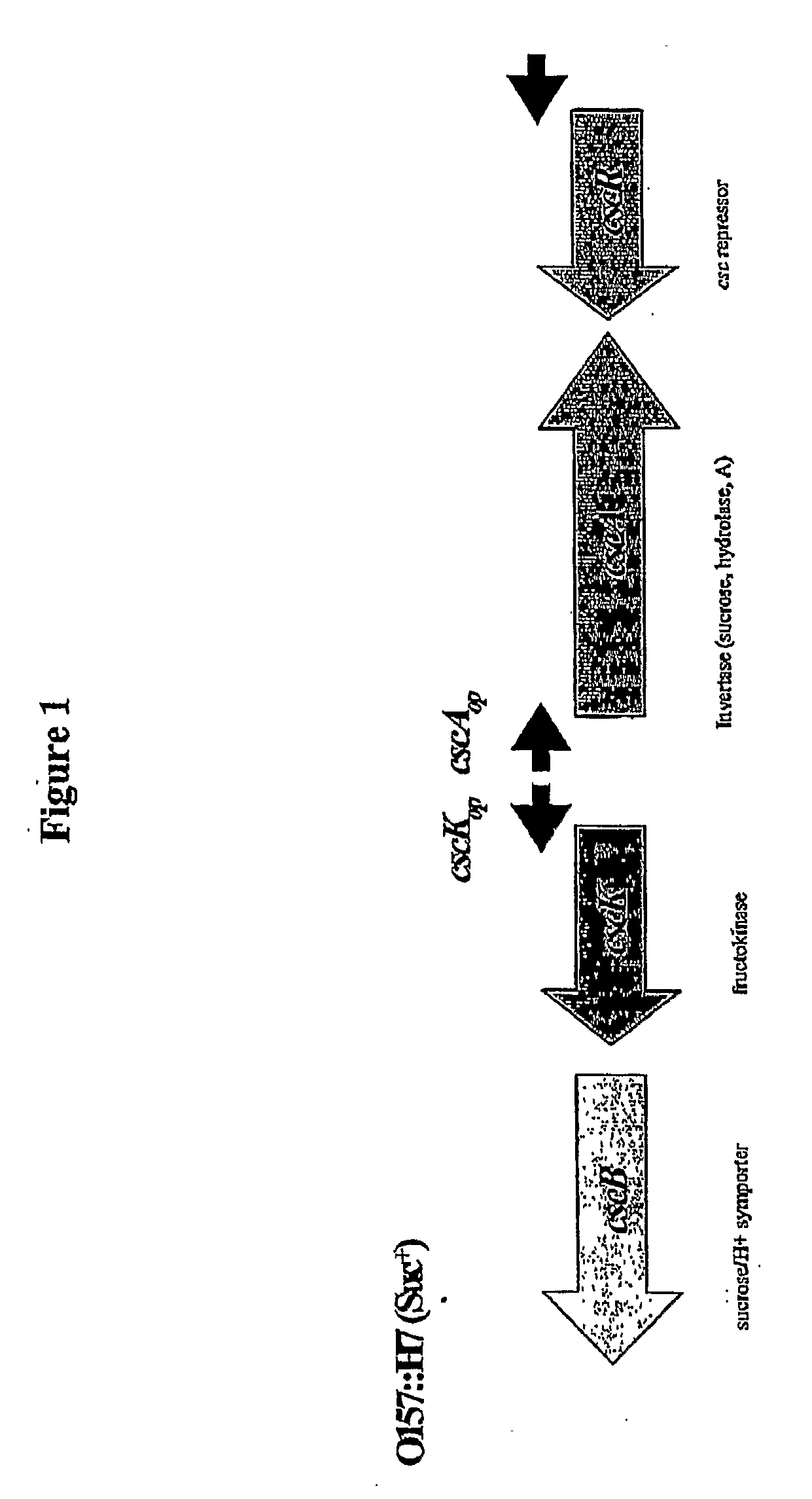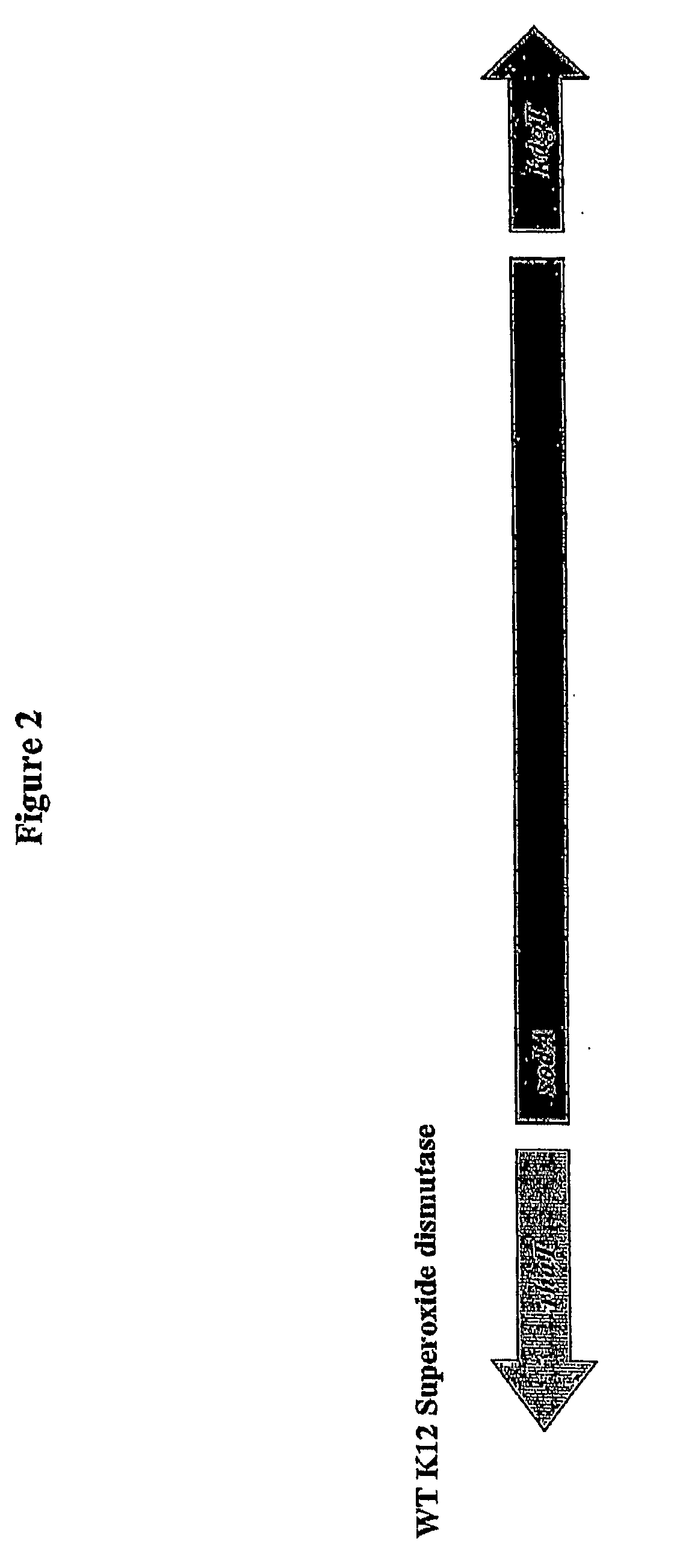Oxygen-regulated microorganisms
a technology of oxygen-regulated microorganisms and microorganisms, which is applied in the field of microorganism strains and fermentation processes, can solve the problems of toxic accumulation of excess acetate, and inability to efficiently metabolize acetyl-coa in cycles
- Summary
- Abstract
- Description
- Claims
- Application Information
AI Technical Summary
Problems solved by technology
Method used
Image
Examples
example 1
Oxygen-Regulated Sucrose Uptake and Metabolism
[0061]A sucrose catabolizing (Suc+) strain of E. coli K-12 was produced by replacing the native soda gene with the sucrose metabolism module of E. coli O157:H7 as shown in FIG. 3. The genes were rearranged from their original configuration within the module by inverting the cscB gene and placing it in line with cscK. The cscR gene was omitted because the promoter-operator region was replaced by the promoter and regulatory elements of the soda gene. It should be noted that the strain could also have been produced without cscK, since the activity of the gene product is redundant to that of the fruK gene of E. coli K-12. The strain could also have been produced by introducing the sucrose metabolism module on a plasmid or into the genome under control of a separate promoter, such as soda.
[0062]Primers 1 (P1) and 2 (P2) were designed to amplify both cscK and cscB as a single 2.2 Kb piece (FIG. 4b). The sequence for P1 was: 5′-CCCACGGAGTGGCTGT...
example 2
Oxygen-Regulated Sucrose Metabolism
[0066]Invertase may be the bottleneck through which sucrose metabolism must flow. As a cytoplasmic enzyme, invertase can turn over more quickly than a membrane protein. This is important in achieving a rapid shutdown of function. In fact, the rate of its degradation can be speeded up if necessary by ubiquitin tags and other such modifications. By contrast, levels of cscB are is unlikely to be quickly regulated since the symporter is a membrane protein. As a result, we produced the Suc+ strain shown in FIG. 6. The construct provides a separate operon for independently controlling the sucrose symporter cscB using a lac promoter. As before, the fructokinase gene (cscK) may be superfluous.
[0067]Primers 4 and 5 were designed to amplify cscA (1.4 kb) from O157:H7 genomic DNA. P4 was the same primer described in Example 1. The sequence for P5 is: 5′-CAAAACCACATCAATTGAAACGCTGTTTTATTTTTATCGGATCATTGTTTTTAA CCCAGTAGCCAGAGTG-3′ (SEQ ID NO: 5). Thus, the cscA g...
example 3
Control of Sucrose Metabolism by an Oxygen-Sensitive Promoter and Sucrose Uptake by a Sucrose Repressor for Sucrose Positive Bacteria
[0071]The third example preserves the sucrose repressor CscR to control the level of sucrose in the cell in a normal fashion for sucrose positive strains such as O157:H7. This scheme is tantamount to transplanting the cscA gene from the normal position in the sucrose operon of O157:H7 into the sodA operon. This method of control may be the most effective in regulating acetate because the pool of sucrose will be fixed and the only controlling function is the level of invertase, the bottleneck enzyme. The cscR gene is eliminated from this scheme, which results in constitutive transport of sucrose and fructokinase activities. As before, the sodA gene may either be replaced by cscA or combined in series with cscA as shown in FIG. 8.
[0072]Primers 4 and 5 were designed to amplify cscA (1.4 kb) from 0157 genomic DNA. P4 and P5 were described in Example 1. Thu...
PUM
 Login to View More
Login to View More Abstract
Description
Claims
Application Information
 Login to View More
Login to View More - R&D
- Intellectual Property
- Life Sciences
- Materials
- Tech Scout
- Unparalleled Data Quality
- Higher Quality Content
- 60% Fewer Hallucinations
Browse by: Latest US Patents, China's latest patents, Technical Efficacy Thesaurus, Application Domain, Technology Topic, Popular Technical Reports.
© 2025 PatSnap. All rights reserved.Legal|Privacy policy|Modern Slavery Act Transparency Statement|Sitemap|About US| Contact US: help@patsnap.com



